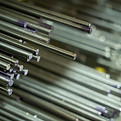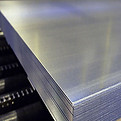316H Stainless Steel | Intamet Ltd
316H is a high carbon variant of 316 stainless steel. The "H" in the name indicates a higher carbon content compared to regular 316.
This higher carbon content makes it stronger in terms of both yield strength and tensile strength.
316H is a high-carbon variant of 316 stainless steel. The "H" in the name indicates that it has a higher carbon content than standard 316. More carbon makes the steel stronger, so it's better for high-stress places.
316H has better resistance to intergranular corrosion, which happens when the steel is exposed to high temperatures. This makes it less susceptible to sensitisation, a condition that can lead to premature failure of the material. The improved resistance to intergranular corrosion is due to the presence of titanium, which helps to stabilise the steel's microstructure.
316H is commonly used in the petrochemical and chemical processing industries, where the steel's high strength and corrosion resistance are highly valued. It is also used in power generation, offshore oil and gas production, and other high-temperature environments.
The material is also used in the production of heat exchangers, boilers, and other pressure vessels. It is also used in the construction of flanges, fittings, and valves. The steel is also suitable for use in the manufacture of medical instruments, such as surgical instruments and implantable devices.
Physical & Mechanical Properties of 316H
The physical and mechanical properties of 316H stainless steel can vary depending on the specific grade and manufacturer, but generally, it has the following properties:
Density: 7.98 g/cm3
- Melting point: 1370-1400°C (2500-2550°F)
- Tensile strength: 515-655 MPa (75-95 ksi)
- Yield strength: 205-485 MPa (30-70 ksi)
- Elongation: 40% min
- Hardness (Brinell): 217 max
- Modulus of Elasticity: 193 GPa (28 x 106 psi)
Due to its high-carbon content, 316H has a higher strength than standard 316 stainless steel. This makes it more suitable for use in high-stress applications such as pressure vessels, heat exchangers, and boilers. The high strength of 316H also means it will have less ductility than other grades of stainless steel, which means it may be more prone to cracking and brittle failure. The steel has good resistance to corrosion in high-temperature environments, due to the presence of titanium in its chemical composition.
Please note that these properties are approximate and may vary depending on the specific grade and manufacturer of 316H being used. Additionally, the properties may also change depending on the temperature and environment the steel is being used in.
Chemical Composition of 316H
The chemical composition of 316H typically includes:
- Chromium (Cr): 16-18%
- Iron (Fe): balance
- Nickel (Ni): 10-14%
- Molybdenum (Mo): 2-3%
- Titanium (Ti): 0.5-0.7%
- Carbon (C): 0.04-0.10%
- Manganese (Mn): 2% max
- Silicon (Si): 1% max
- Phosphorus (P): 0.045% max
- Sulfur (S): 0.03% max
- Carbon (C): 0.08% max
- Nitrogen (N): 0.1% max
Please note that the chemical composition may vary slightly depending on the manufacturer or the specific grade of 316H being used. Additionally, there may be small amounts of other elements present, such as copper or nickel. 316H has a special chemical makeup to make it stronger and more resistant to corrosion, especially in tough and hot conditions.
Variants of 316
There are different types of 316 stainless steel made for specific uses or to enhance certain material qualities. Some of the most common variants include:
- 316Ti is a type of 316 that has titanium added to it. This makes it more resistant to corrosion, especially in hot and chloride-rich environments.
- 316L: This variant of 316 is low carbon, for improved resistance to intergranular corrosion and improved welding characteristics
- 316H: This variant of 316 is a high carbon version, which improves its strength and hardness. It is often used in high-stress applications such as valves and pumps.
- 316LN: This variant of 316 is nitrogen-alloyed to improve its strength and toughness. It is often used in high-stress applications such as aerospace and nuclear power plants.
- 316F is a type of 316 that is easy to machine. It has sulfur added and is commonly used for making gears, bearings, and precision parts.
- 316L Mod: This variant of 316 is modified to improve its machinability. It is often used in the manufacture of gears, bearings, and other precision components.
- 316L-Si: This variant of 316 is alloyed with silicon to improve its resistance to corrosion and oxidation. It is often used in high-temperature applications such as furnace components and heat exchangers.
Please note that the above variants are just a general representation, and other variants exist to meet specific requirements, such as 316L-Mo for improved resistance to pitting and crevice corrosion, 316L-Cu for improved resistance to stress corrosion cracking.
AVAILABLE FORMS
Intamet offers 316H in a wide range of forms, including the below:

Tubes & Pipes

Fitting & Flanges

Round Bars
